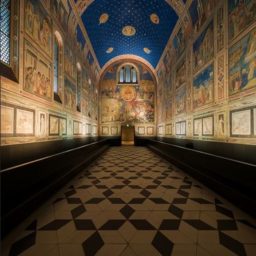Padua’s celebrated Scrovegni Chapel, which houses exceptional frescoes by trecento painter and architect Giotto, was struck by a bolt of lightning on August 9.
The iron cross on the facade was seriously damaged and subsequently removed. The entire electrical system was temporarily knocked offline. The Gazetta del Sud also reports the damage of outside stones.
According to Il Secolo XIX, the news was broken almost three weeks after the event by the local association “the Amissi Piovego.” The group raised the alarm before any statement from city hall was released.
The silence of local officials infuriated former cultural heritage councilor Giuliano Pisano, who claims it is not impossible that the frescoes themselves were harmed by the incident.
Quoted in the Italian newspaper, he lambasted the city administration: “It is absolutely scandalous that we only learned about this collapse from a citizens’ association and not from the town hall,” he said. “We’re talking about Giotto’s chapel, heritage of humanity. How is it possible that the council didn’t say anything?”
Padua mayor Massimo Bitonci confirmed the incident and responded to criticism by arguing that he was waiting for an “expert examination by a specialized firm before giving out the news.”
Fabrizio Boron, the local councilor in charge of monuments attempted to be reassuring: “I am not aware of damage to the facade except, perhaps, for things that already needed maintaining and that had already deteriorated,” he said. “Certainly there was no damage about which to be concerned.”
He was also quick to point out that the chapel had recently been granted €500,000 by the government for the maintenance of the priceless frescoes. The sum may be used to find a solution for the chapel’s crypt, which is regularly flooded.
Also known as Arena Chapel due to its proximity to the site of a former Roman arena, the Scrovegni Chapel was commissioned in the early 14th century by local banker Enrico Scrovegni.
Giotto’s cycle of frescoes, which adorn its internal walls, are dedicated to the Virgin Mary and human salvation (perhaps as a way for Scrovegni to purchase his own). They were completed in 1305.
The Scrovegni Chapel is a UNESCO World Heritage site. It underwent major restoration in 2002.
